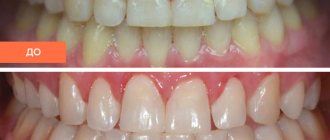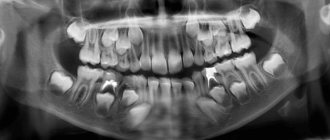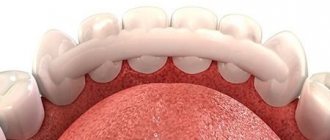From this article you will learn:
- types of professional and home whitening,
- which method is better and safer,
- teeth whitening in St. Petersburg and Moscow – prices 2022.
The article was written by a dentist with more than 19 years of experience.
Cosmetic teeth whitening can be professional, in which case it is performed in a dental clinic, or at home, using at-home products (for example, Crest whitening strips, Opalescense whitening gel, and special toothpastes).
As a dentist, I have to admit that home remedies for teeth whitening are becoming more effective every year. Already today, some of them allow you to achieve results that are quite comparable to the effectiveness of professional teeth whitening techniques - such as “Zoom”, “Beyond Polus”, “Opalescence Boost”, etc.
There is a lot of misinformation being circulated regarding professional and home whitening. For example, you will never be able to lighten your teeth by 8-12 shades - which is what they constantly say in advertising. The real result is 4-6 tones on the VITA scale (Fig. 2). And besides, whitening is not as safe for the hard tissues of teeth as they try to make it out to be.
In this article we will talk about the pros and cons of all the main methods of home and professional whitening, compare their cost and effectiveness. Below you can read reviews on teeth whitening, as well as see “before and after” photos of various whitening techniques.
How does teeth whitening work?
Both home and professional teeth whitening use the same principle of chemical whitening - through the use of peroxide compounds (hydrogen peroxide or carbamide peroxide). These substances, with prolonged contact with the surface of the teeth, are able to penetrate the entire depth of enamel and dentin. Penetrating into the tooth tissue, they gradually disintegrate with the release of free radicals, namely atomic oxygen (Fig. 3).
It is atomic oxygen that leads to the destruction of molecules of chromogenic substances (pigments), which give teeth a dark color. To make the whitening process more effective and safe, hydrogen peroxide or carbamide peroxide is used in the form of a highly concentrated gel.
In professional whitening products, a whitening gel is applied by the dentist to the front surfaces of the upper and lower teeth. In home whitening products, the whitening gel is usually pre-applied to the inner surface of whitening strips or special dental trays (which the patient will have to apply to the teeth for a while).
Evaluating the effectiveness of bleaching –
The effectiveness of whitening is assessed by comparing the shade of teeth before and after the whitening procedure. Most often, the “Vita” tooth shade scale is used for this (Fig. 2). We have already said above that the use of even the most effective whitening products allows you to lighten your teeth by an average of 4-6 shades (tones). Accordingly, in Fig. 5 you can see what difference can be achieved.
Teeth of different shades may respond differently to whitening. So, the whitening effect (before and after results) will be most noticeable if your teeth are yellowish. If you want to whiten teeth that are already quite light, the effect will be minimal - no more than 1-2 tones. As for teeth with gray and brownish shades, even professional teeth whitening in a clinic will be ineffective.
Historical reference
In the 19th century, teeth whitening was more of an experimental nature, since it was carried out on non-living teeth by applying one or another substance with bleaching properties to their vestibular surface: chlorine, oxalic acid or ammonia. Over time, a method of whitening using hydrogen peroxide developed. Thus, the first positive experiments were recorded in 1847. In 1918, a revolutionary method of teeth whitening using hydrogen peroxide under the influence of thermal radiation, which significantly accelerates the chemical process, took place. But it was noticed that this method demineralizes and thins the enamel, which leads to its subsequent destruction and the occurrence of caries. In the early 90s of the twentieth century, a laser whitening method appeared. It was this that formed the basis of modern whitening systems using laser, plasma, infrared and light systems. And although today many of the mechanisms of whitening are not yet fully understood, it is known that the basis of this process is an oxidation reaction, during which the molecules that cause “pathological” staining of enamel and dentin are broken down, and the use of light and heat enhances this process. At the same time, in the 90s, aggressive advertising of whitening products for self-use began - home whitening. Their widespread use has become a dangerous trend, because the lack of preliminary diagnosis, the use of bleaches in inappropriate conditions, non-professional preparation of protective equipment - all this led to defects that worsened the initial situation: uneven color distribution, destruction of restorations, etc. But a large-scale campaign to inform people about the reliability and unique possibilities of professional whitening, carried out by qualified specialists or under their supervision, led to the fact that in subsequent decades the most effective method of teeth whitening became professional clinical teeth whitening - a dental procedure to change the existing color of teeth to a more light shade.
Teeth whitening: price 2022
So, how much does teeth whitening at the dentist cost, and how much cheaper will it be to do it at home... Below we will list the most effective home and professional teeth whitening - types and prices in Moscow and St. Petersburg for 2022, and further in the article we will analyze in detail the pros and cons of each type bleaching. Prices are indicated for mid-price clinics.
1) Professional whitening techniques –
- Zoom-4 – from 15,000 rub.
- Beyond Polus – from 10,000 rub.
- Opalescence Boost PF – from RUB 9,000.
2) Home whitening –
- whitening strips – from 2500 to 5500 rubles.
- whitening gel and Opalescense dental trays – from 4,300 rubles.
Important: in some clinics you may see prices significantly lower than those indicated by us (for example, Zoom costs 8,000 rubles). Only the cost of the original set of Zoom consumables for 1 patient is about 9,500 rubles (Fig. 5). Therefore, if you see prices for Zoom whitening in the range of 8,000 - 10,000 rubles, this will mean that the clinic will not use original materials, but analogs/counterfeits made in China.
Who should not go for whitening?
- People with any inflammatory gum diseases.
- People who have been diagnosed with a pulp chamber, as bleaching can cause tissue burns.
- People with untreated carious lesions. Those who already have fillings need to be careful too. Filling material does not whiten as well as teeth, so it may bleed.
- People with tooth hypersensitivity and a tendency to increased enamel abrasion. In this case, the whitening procedure is a direct path to irreversible tooth damage.
- People who have had their molars removed under general anesthesia , as well as other complex dental surgeries. It is necessary to wait for complete recovery before bleaching.
- People with allergies to components of peroxide and other chemical compounds used during the procedure. Contact with them will be quite long, so you should not ignore even weak negative reactions of the body.
Also, pregnant women should not whiten their teeth. This limitation is conditional and many women neglect it because they want to look great in their first photos with their baby. But still, pregnant women often experience gingivitis due to changes in hormonal levels - looseness of the gums. If they come in contact with bleaching chemicals, they may cause a deep burn. The gums will bleed and hurt. Whether the expectant mother needs this, taking into account all the prenatal cares, is a big question.
There is also a conditional age limit. Doctors do not recommend performing the procedure on children under 18 years of age. Their tooth enamel is not yet strengthened enough. And there can be no indications as such for bleaching. Light yellowness can be removed using Air Flow or ultrasonic cleaning. After them, all tartar should be gone, and to lighten the teeth, the doctor will prescribe a special toothpaste.
Professional teeth whitening at the dentist –
Today there are 3 main types of professional whitening. The first two methods: photo whitening and laser teeth whitening imply that, in addition to the whitening gel, a special light source (laser or special whitening lamp) will also be used. The third method, when only whitening gel is used, is no less effective.
Today, the most popular in-office whitening methods are “Zoom” (Fig. 4-6) and “Beyond Polus”. These are photo teeth whitening techniques that involve the use of not only a gel with hydrogen peroxide during the procedure, but also a special whitening lamp. Such lamps do not have their own whitening effect and are designed to increase the rate of breakdown of hydrogen peroxide into free radicals.
Zoom-4 lamp and whitening kit –
Clinical teeth whitening at the dentist has undeniable advantages. First of all, it requires only 1 visit to the dentist, and the duration of the procedure takes only 1 hour - in contrast to the long daily use of home whitening systems for 10-20 days. In addition, the procedure itself takes place under the supervision of a dentist, which reduces the risk of side effects and increases the effectiveness of the procedure. But, in principle, this is where the advantages end.
In terms of effectiveness, the effectiveness of professional and home whitening systems is almost equal. This turned out to be possible thanks to the fact that many high-quality foreign manufacturers of dental materials, along with professional whitening systems for dentists, began to produce kits for home whitening - such as “Opalescense” and “Perfect Bleach”. They are produced by such well-known manufacturers of dental materials as ULTRADENT (USA) and VOCO (Germany).
Thus, in both home and professional systems, in principle, the same technologies are used. In addition, we must admit the following: statements by dentists that professional whitening leads to teeth lightening by 8-12 shades, and that the effect lasts for 3-5 years - all this has nothing to do with reality and is largely advertising. And that's why…
→ Reviews about the Zoom-4 whitening method
Teeth whitening before and after: photo
Below you can see what real results of professional whitening can be achieved (without editing before and after photos in Photoshop).
Significant disadvantages of professional whitening –
- The degree of whitening will be lower than expected - the dentist will measure the color of your teeth using a special Vita scale - before and immediately after the whitening procedure.
The problem is that teeth lose a lot of moisture during whitening, and overdried teeth always look whiter than they actually are. Therefore, the color that you see immediately after the procedure will only be temporary. Within 24-48 hours, when the hard tissues of the teeth are saturated with water contained in the oral fluid, the color of the teeth will become much darker than what the dentist will measure for you on the Vita scale. If your dentist persistently guarantees that your teeth will be brightened by 6 or 8 tones, then ask him to measure the color of your teeth not immediately after the procedure, but after 1-2 days, and ask him to include this clause in the contract for the possibility of a refund. Believe me, the dentist’s mood will immediately change... - Duration of the whitening effect - when they tell you that the whitening effect will last for several years - all this is not entirely true.
The fact is that there is a direct relationship: the shorter and more aggressive the whitening procedure, the faster the color will “rebound” back. That is why, after completing the in-office whitening procedure, the dentist will strongly recommend purchasing a home whitening system from their clinic (to maintain its results). Without this home whitening system, the color of your teeth will quickly return, and within 3-5 months the effect will no longer be noticeable at all. The duration of the effect when using home whitening products (such as whitening strips or trays) will be significantly longer, because Such remedies are used over a course of 10 to 20 days and the effect is achieved gradually. - Cost of Teeth Whitening – Professional teeth whitening costs significantly more than home whitening. For example, teeth whitening like “Zoom!” will cost you an average of 15,000 rubles. But in addition, you will have to plan on spending on a home whitening system to support the results of office whitening, which will cost you up to 15,000 rubles (if purchased at a dental clinic.
- Frequent side effects – because.
In a 1-hour procedure, it is necessary to achieve significant teeth whitening - professional whitening will naturally be very aggressive. Only 55% of patients who have undergone professional whitening have positive reviews. The most common complication is shooting pain in the teeth, which can last from several days to several weeks, and taking tablet analgesics practically does not help reduce the pain. That is why teeth whitening at the dentist is contraindicated for people with hypersensitive teeth. In such patients, acute pain occurs already during the procedure, which often leads to the need to stop the whitening procedure without completing it. If your teeth react to thermal or mechanical irritants, you should not do whitening in principle, no matter how much the dentist persuades you (motivating that teeth remineralization courses before and after the procedure will help prevent this). They won't help.
Anatomy of tooth enamel
Enamel is a protective layer covering the crown of a tooth. It is the hardest tissue in the human body, since it consists of 97% inorganic substances: fluorine, iron, lead, zinc, carbonates, magnesium, sodium, copper, aluminum, potassium, strontium and others. The organic matter of enamel consists of proteins, carbohydrates and lipids. In different areas, the enamel shell has different thicknesses, reaching a maximum in the area of the tubercles. Its surface layers have the highest hardness, but at the same time they are very fragile, especially near the neck of the teeth, where the thickness of the enamel is only about 0.01 mm.
The main structural formation of enamel is enamel prisms - structures formed from hydroxyapatite crystals with a diameter of no more than 4-6 microns, having a tortuous shape, due to which their length exceeds the thickness of the enamel. When collected in bundles, the prisms form s-shaped bends, so light and dark stripes, as well as oblique lines, can be seen on enamel sections. In addition to prisms, tooth enamel contains spindles, fascicles and plates - formations that penetrate the enamel to small, medium and large depths, respectively. The inner and outer layers of enamel running at the cemento-enamel boundary do not have prisms and are therefore called prismless enamel. The main function of enamel is to protect dentin and pulp from external influences - temperature, mechanical and chemical, and thanks to the characteristics of the strength and hardness of enamel, we can bite, grind and grind even coarse and hard food without damaging the teeth.
What is laser teeth whitening –
There are several different types of professional whitening. For example, the “Zoom-4” and “Beyond Polus” techniques refer to the so-called “photobleaching”. This is because they involve the use of a special whitening lamp that emits different wavelengths of light at the same time (for example, in the range of 400 to 500 nm). Such lamps make it possible to increase the rate of decomposition of hydrogen peroxide into atomic oxygen.
But there is also so-called laser teeth whitening - with systems such as Picasso (AMD LASERS), Smartbleach®, etc. This technique also requires the presence of a light source, which is a laser beam of one strictly defined wavelength (for example, 810 nm). The disadvantage of this technology is a slightly greater risk of overheating of dental tissues, which can lead to the development of aseptic pulpitis, as well as the high cost of the procedure.
For example, in different dental clinics for photo and laser teeth whitening, the price usually varies on average from 15,000 to 30,000 rubles (the minimum price is from 10,000 rubles), and this does not include the cost of maintenance therapy that you will have to carry out at home.
Why are whitening lamps and lasers needed? For many years, there have been debates in dentistry - whether activation by light really speeds up and improves the process of teeth whitening... or is it just marketing that allows these systems to give a more professional look, which also allows them to be justified in the eyes patients their very high price. Independent clinical studies by different authors (Hein 2003; CRA 2003; Kugel 2006, etc.) showed that the whitening results were the same - both in cases where only the whitening gel was used, and in cases when the same gel used in conjunction with a light source.
Professional whitening without light sources –
There are also professional chemical whitening techniques that do not require any light sources. An example is the Opalescence Boost PF whitening system based on a whitening gel with 40% hydrogen peroxide. This system, produced by ULTRADENT (USA), is no less effective than photo- and laser whitening methods, and due to the absence of the need to use an expensive light lamp, the cost of the procedure will be significantly lower.
Color and optical properties of enamel and dentin
The color of teeth has several basic characteristics - shade, intensity, transparency, as well as several additional optical properties that are difficult to detect by the human eye. These include opacity (low light transmittance, opacity), fluorescence (glow), surface gloss and others. Tooth enamel is practically colorless, but has properties important for the vitality of the tooth: transparency, shine, fluorescence and opalescence (the ability to scatter light). The color of the tooth is maximally manifested in the dentin layers. The pigments they contain are capable of selectively reflecting light rays, creating individual shades of the crown of the tooth. The characteristic protrusions of dentin (mamelons) are almost always bordered by milky blue enamel with a cream rim along the cutting edge. This optical phenomenon is called the halo effect, and without it the tooth would not have visually defined boundaries and would blend into the dark oral cavity. It is important to understand that the healthy state of dentin (including the “health” of its optical properties) provides a beautiful tooth color and, on the contrary, due to disorders and pathologies of the dentin layers, the color of the teeth changes significantly.
Teeth whitening products at home –
Home teeth whitening products also contain hydrogen peroxide or carbamide peroxide as active ingredients, i.e. in this they are no different from professional whitening products. The difference lies only in the concentration of active components, which in this case will be 2-3 times lower. Lower concentrations are compensated by frequency of use, and the average course of home whitening lasts from 10 to 20 days.
Accordingly, you should be prepared for the fact that the visible effect will become noticeable only on days 3-5 (from the start of the home whitening course). When choosing teeth whitening products at home, you will have to make a compromise between convenience and effectiveness. The most convenient way is to use special whitening strips, the most effective is to use special dental trays and whitening gel. As for whitening toothpastes, their effect will be minimal (on average only 1 tone).
Using whitening strips –
In Russia, the best brands of whitening strips are “Crest 3D White” and “Blendamed 3D White Luxe”.
Both brands are owned by (USA). There is a whole line of Crest strips, which differ from each other mainly only in the concentration of hydrogen peroxide - from 9.5 to 14%. Blendamed strips contain only 5.25% peroxide, and are also quite poorly fixed to the teeth. The hydrogen peroxide whitening gel is applied to the inside of the strips, and all you have to do is apply them to your teeth and press. Next, the strips should remain on the teeth for 30 to 60 minutes (depending on the concentration of hydrogen peroxide). Depending on the type of strips, procedures are done daily 1 or 2 times a day for 10-20 days.
→ Reviews of the use of Crest whitening strips
Important: it should be noted that this type of whitening is more suitable for patients with straight teeth, and is not very suitable for patients with crowding, severely inclined teeth... With uneven teeth, the strips are very difficult to adapt so that they fit evenly and tightly to the teeth. In places where the strips do not fit well, the tooth enamel will remain the same color and will look like dark spots. Crest “FlexFit®” strips will provide the best fit to uneven tooth surfaces.
Using dental trays and whitening gel –
This type of home whitening is the closest in effectiveness to professional whitening, but at the same time has a significantly lower price. The most effective option would be to use Opalescence PF whitening gel containing 10%, 15% or 20% carbamide peroxide (Fig. 11). The cost of Opalescence PF is from 4,300 rubles, however, this whitening option will require the production of individual whitening trays from the dentist (Fig. 12), the cost of which will be about another 3,000 rubles.
Moreover, such individual dental trays can be used repeatedly and for repeated whitening courses. The second option for the lazy is to use universal Opalescence “TresWhite Supreme” dental aligners, which are already pre-applied with a whitening gel based on 10% hydrogen peroxide (Fig. 13). Thus, you no longer need to make additional mouth guards, and all the fun will cost you only 4,500 rubles.
Important: the use of Opalescence “TresWhite Supreme” dental trays already filled with whitening gel is quite effective and, most importantly, convenient. You only need to bite the mouthguard with your teeth, then remove the hard outer layer, and press the inner translucent layer of the mouthguard with your fingers to your teeth (wear for up to 60 minutes). However, if you want to get the maximum effect, then Opalescence PF is the best home teeth whitening product. The custom tray option allows you to use the most effective “overnight” whitening option, where the trays remain on your teeth all night.
→ Reviews on the use of Opalescence dental aligners
Use of whitening toothpastes –
Toothpastes are the weakest method of teeth whitening, and do not make them lighter by more than 1-2 shades. Moreover, the most effective whitening pastes are those containing carbamide peroxide, i.e. they also implement a chemical bleaching mechanism. There are only a few pastes containing carbamide peroxide on the Russian market, the cost of which ranges from 350 to 1450 rubles.
The largest group of whitening toothpastes are those with a high content of abrasives. Such pastes make teeth lighter by allowing them to “scrape” external impurities from the surface of the teeth. But such pastes are not capable of changing the color of the actual dental tissues (24stoma.ru).
→ Rating of whitening toothpastes 2022
Home teeth whitening: before and after photos
Reasons for color change
So, the first step to making your smile attractive is to visit a doctor. It is at this stage that the reasons leading to the unsatisfactory appearance will be determined. If you understand where to look and know what to ask the patient about, you can draw up a detailed picture of the disease and deduce cause-and-effect relationships.
What are the main causes of darkening of teeth?
- Poor oral hygiene . If you neglect thorough care, that is, brush your teeth less than twice a day and do not use floss, then sooner or later this will affect not only the appearance of your teeth, but also their health.
- Food and drinks . Foods contain natural or artificial colors that are firmly attached to the surface of the teeth. If you are addicted to cola or red wine, then a dark film will quickly settle on your teeth.
- Injuries and diseases . If one or more teeth suddenly darken after a blow, illness or treatment, then this is a reason not to postpone a visit to the doctor. This signal usually indicates that immediate intervention is required.
- Taking medications . Teeth are human tissue, like many other things. If during their formation the body of the mother or child was exposed to certain drugs, this can lead to problems with their appearance. The infamous yellow “tetracycline” teeth are a prime example of this.
- Age-related changes . Over the years, the enamel absorbs dyes from the foods it eats and gradually darkens.
Is teeth whitening safe: reviews
Below we will list several important points that will be useful for you to know when deciding whether to undergo whitening in principle. In general (when performed correctly and accurately), whitening is a fairly safe procedure if performed in patients with well-mineralized tooth enamel and good oral hygiene. But there are some subtleties, for example...
Negative effects on tooth tissue –
You should not believe statements that whitening does not lead to demineralization of dental tissues (loss of calcium). Independent clinical studies Sighiand Denry" (1992), McCracken et al. (1996) showed that chemical bleaching leads to a decrease in enamel strength and wear resistance to abrasives and acids. That is why the manufacturer of the Zoom whitening system recommends remineralizing therapy not only after the whitening procedure, but also before it begins for all patients.
And the higher the concentration of hydrogen peroxide is used, the higher the degree of demineralization of enamel and dentin. Accordingly, professional whitening techniques that use higher concentrations of hydrogen peroxide or carbamide peroxide lead to more pronounced demineralization. But there is a subtle point here too. For example, Zoom whitening uses a whitening gel with a 25% concentration of hydrogen peroxide, and Opalescence Boost PF whitening uses 40%. But in this case, less does not mean safer.
The fact is that Zoom involves the use of a bleach lamp, which accelerates the decomposition of hydrogen peroxide into free radicals. It is they that have the whitening effect, and not the hydrogen peroxide itself. The lamp allows you to create higher concentrations of free radicals in dental tissues, which also have a damaging effect on teeth. Thus, it seems that the concentrations of 25% and 40% gels are different (and the first one seems safer), but using a lamp together with a 25% gel will give the same concentration of free radicals as using a 40% gel without a lamp.
Important: in patients with a large number of wedge-shaped defects in the necks of teeth, as well as white spots on the enamel, increased demineralization of tooth tissues as a result of whitening can cause the progression of these dental diseases. It is possible to increase the number/depth of wedge-shaped defects and the formation of carious defects in place of white spots on the tooth enamel.
Negative effects on fillings –
Independent clinical studies by Della Bona et al. 1992, Tiunsakeretall 1990, Titleyetall 1991 found that chemical bleaching disrupts the bond between tooth dentin and filling materials. Both light composites and glass ionomer cements. As a result, the marginal fit of the filling to the tooth tissue deteriorates, which increases both the risk of developing caries at the filling/tooth interface and the likelihood of fillings falling out.
Fillings and crowns are not subject to bleaching –
Chemical whitening can only make natural tooth tissue whiter, but fillings, crowns or veneers cannot be whitened at all. This is important if you have a filling or crown on one or more front teeth, because after whitening they will remain the same color and will stand out sharply against the background of whitened tooth enamel. Whitening in such situations may require subsequent replacement of fillings/crowns with lighter shades.
Important: As we said above - most of these negative effects will be especially pronounced in patients with insufficient/irregular oral hygiene, patients with a large number of fillings, crowns or missing teeth, as well as patients with weak mineralization of tooth enamel. But for most other patients, teeth whitening is a fairly safe procedure.
Contraindications
In some cases, teeth whitening is not just harmful, but unacceptable. Your doctor will determine whether you can whiten your teeth or not. If a patient has contraindications, but still whitens his teeth, he may face serious oral diseases.
Diseases and conditions for which teeth whitening is contraindicated:
- open caries;
- pathological abrasion of enamel;
- deep cracks in teeth;
- gum disease;
- wearing braces;
- exposure of tooth roots;
- allergy to bleaching agents.
In addition, teeth whitening is contraindicated for minors, as well as pregnant and breastfeeding women.









